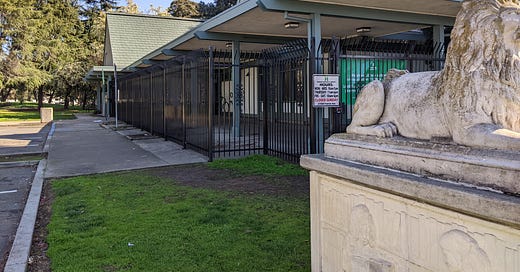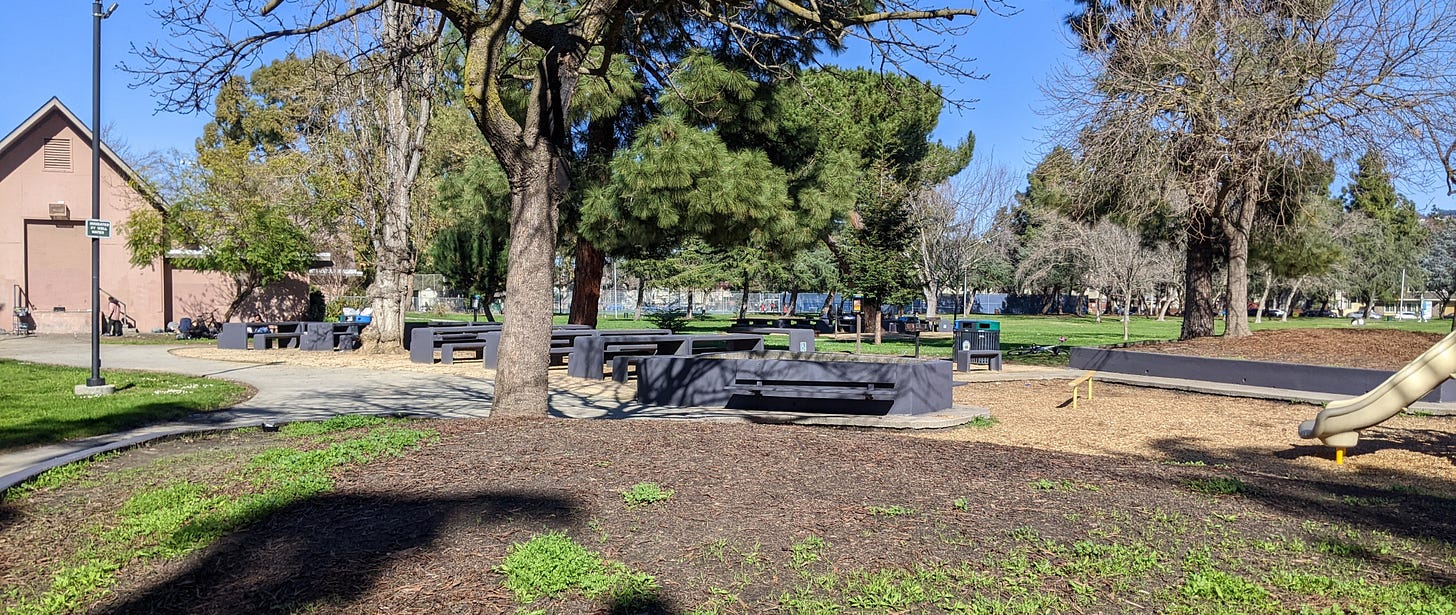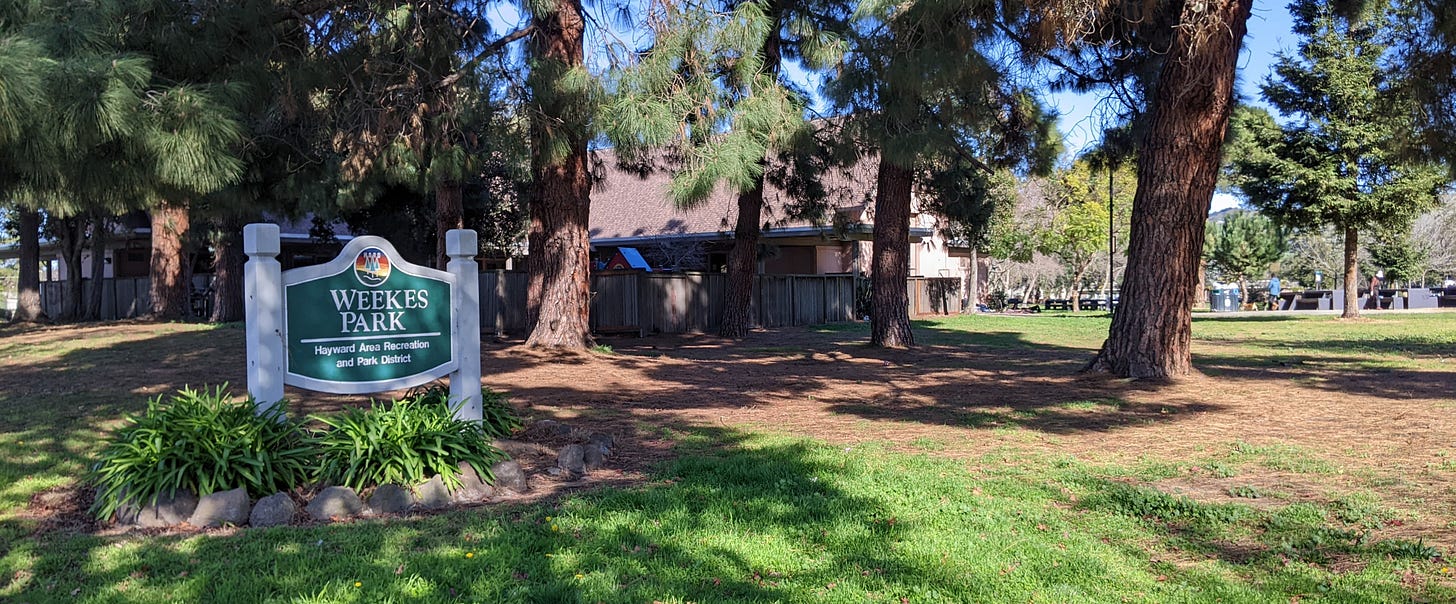These Are Our Folks
In Which: Fremont may criminalize being poor, HARD may build a fence around Weekes Park to keep out unhoused people, Things we can do that actually help.
“…You haven’t any money. Maybe it would be better if you could go to Europe.”
“Why?” I asked.
“Because in Europe poverty is a misfortune, but in America it is shameful.”
-John Steinbeck
Fremont Leads On Punishing Homelessness
Tonight, the Fremont City Council is set to vote on some of the harshest anti-homelessness laws in the Bay Area—and possibly the whole state. The proposed law would not only make sleeping outside an crime—effectively criminalizing homelessness—but allow seizing and destroying personal belongings, and make anyone who attempts to help them “aiding and abetting.” This would be punishable with up to $1,000 in fines and six months in jail.
Fremont’s ordinance is horrifying. It reveals the lengths to which gentrification will go to disappear people who are poor. Although the Mayor of Fremont, Raj Salwan, told CalMatters that the “aiding and abetting” clause was supposed to target alleged vigilante structure-builders, when asked if it would apply to someone helping to pitch a tent he responded, “That’s a good question. I think we may have to seek clarification from the city attorney.”
Criminalizing those who give help other human beings find shelter may sound far-fetched, but anti-homelessness rhetoric isn’t isolated to Fremont. At recent City Council and the Hayward Area Recreation and Park District (HARD) Board of Directors meetings, the subject of homeless residents in Weekes Park has become the next flash point between the State and unhoused people.
Today, we’re going to cover Weekes Park: what’s happening, what’s being done about it, and why we’re choosing that over something that works.
What Happens At Weekes Park Is Not New
Weekes Park is one of the largest contiguous parks in South Hayward and long been a location for activity on the edges. There are stories going back to the 60s about drug dealers and unhoused people frequenting the park. The large grassy fields and wooded areas have never been activated, so they’re a haven for those with nowhere else to go.
Despite adding a handball court and some pickleball courts to the existing amenities—picnic areas, playground, baseball diamond—the majority of Weekes Park is still open spaces of grass and trees. Up until recently, that was enough to hide activity that people didn’t want to see.
But the eviction wave of 2023, brought on by the end of COVID-era tenant protections, and cost of living increases have resulted in more people on the streets. Most Americans are a $500 surprise bill away from losing their home, after all. And some of those who lost their homes undoubtedly wound up in Weekes Park.
Addressing A Visible Issue
Homelessness takes a lot of forms: couch surfing, multiple families living in one home, or living in a car or RV. But visible homelessness is a term used to describe a person living on the street. It’s visible homelessness that causes people complain on Nextdoor about unhoused people.
In an effort to address visible homelessness in Weekes Park, the City created a special task force. It includes the Library, the Police Department, the Community Services Department and HARD—South Hayward Parish was later added to the group, as well. The idea was to develop strategies to address complaints of visible homelessness—something Councilmembers Angela Andrews and Francisco Zermeño have been vocal about.
A New Trajectory On How We’ll Be Handling Homelessness
The biggest action to come out of the Weekes Park task force so far was a sweep on the weekend of January 11th. The sweep, conducted by the City and HARD, came on the heels of a week-long outreach effort by City Staff and service providers. Everyone was told the sweep was coming and connected to as many services as possible. By all accounts, it was as humane as a sweep could be.
According to Pastor Aaron Horner, who was present at the sweep, about 30 people were living in Weekes Park before the sweep. Three people, who had already been in the County’s Coordinated Entry system, got beds at the Hayward Navigation center, but the 27 other people likely remained unhoused.
At the time of the sweep, only 4 people were still there—everyone else had moved on. And, if you believe Councilmember Zermeño, “They were all helped, and now [Weekes Park] is Clean & Green. #HaywardOn!”
But Pastor Horner, speaking during public comment, said that 25 City, HARD, and HPD vehicles descended on the park the day of the sweep. “It looked more like a SWAT maneuver,” he said, “than a way to clean up our parks… it was overly intense for what it should have been.” As a result, three of the four people were arrested and had their belongings taken to a distant holding facility. The fourth person was sent to a hospital for medical treatment.
In a later interview, Pastor Horner said, “My only concern is it having a negative effect on what we’re trying to do.” South Hayward Parish focuses on feeding the unhoused and low-income communities and runs one of the only emergency walk-in shelters in Alameda County. Beyond damaging unhoused residents, he largely described the sweep as ineffective. “Several minutes later [after everyone left], most people started to come back to the park,” he said during public comment.
HARD Takes Action Against Unhoused Residents
Shortly after the Weekes Park sweep, the January 21st HARD Board of Directors meeting had a Study Session on “Weekes Community Park Improvements.” The improvements include a bike park area, a full sized soccer field, a 23,000 square foot dog park, and a 50 stall parking lot. The most surprising addition, however, was a new fence completely enclosing the park.
The addition of a perimeter fence to Weekes Park, given the recent actions around the unhoused residents, felt like it was directly targeting unhoused people. However, since the Study Session wasn’t recorded, it’s impossible to know what the HARD Board was thinking.
I reached out to the General Manager of HARD, Jim Wheeler, via email about the fence. “I do not think this is an item we would respond in via email,” he said. “As you know and as you have written in your Hayward Herald, it is complex.” He was unwilling to provide written comment on the matter and I was unable to go to the District Office to speak to him in person.
I also reached out via email to the HARD Board directly, and only President Louis Andrade responded. “The genesis of the study session was to discuss possible design changes,” he said, “that could address complaints of drinking, drug use, vandalism and trash accumulation that are negatively affecting the usage and quality of the park experience at Weekes Park.” On the subject of unhoused residents in Weekes Park, President Andrade said, “I believe that no camping ordinances should be respectfully enforced as camping is not compatible with community park uses.”
Given the scale of Weekes Park, one could argue that a well-maintained camping area—with trash bins, bathrooms, and regular maintenance that one would see at any campground—could be accommodated with ease. The proposed dog park alone is big enough to fit 10 large homes, at 23,000 square feet. But given that the current amenities at the park are barely maintained—the light in the women’s bathroom has been out for months, according to nearby residents—it is doubtful HARD has the interest in maintaining a campsite.
I Think It Comes From How We Dehumanize Each Other
The proposed fence is about removing unhoused people from Weekes Park, even if nobody involved wants to admit it. “If the idea is to shoo away this problem, it’s not gonna solve anything,” said Pastor Horner, who was present at the Study Session. But the idea of making unhoused people disappear is catching on, even within the City of Hayward.
At a recent City Council meeting, the Library Director specifically blamed encampments for a drop in use at the Weekes Branch. This is despite the change also coinciding with the opening of the new Downtown Library. Since the Downtown Library’s opening, not only has Weekes Branch added a perimeter fence, but regular security patrols were added downtown around the Library and Heritage Plaza.
President Andrade’s focus on behaviors like drinking and drug use are consistent with a widespread belief that unhoused residents are only criminalized because of their behavior, not their situation. “We can say ‘They’re behaving poorly. Get them out of here.’” said Pastor Horner. This focus on behavior—which has been shared by members of City Council—makes homelessness a choice and justifies punishment because they could have chosen differently.
Our Society Owns These Issues
But homelessness isn’t a choice, it’s the result of choices that we as a community have made. There’s an analogy that Pastor Horner recalled reading that illustrates the problem. Imagine a game of musical chairs, and after the first round you notice that Gina has a broken foot. Why doesn’t Gina have a chair? Most people would say that it’s because of her broken foot. But the problem isn’t with Gina, the problem is that we took away a chair.
Sweeps do not solve homelessness, they hide it and make it worse. Not only do people come right back, it prolongs their homelessness and, in many cases, kills people. Pastor Horner believes we need to change how we see our unhoused neighbors. “If you wanna improve your quality of life,” he said, “you need to improve the quality of life for everyone in the community… these are our folks.” If we care for them instead of criminalizing them, it improves things for everyone.
The people who live on the streets near you often used to be your neighbor. “If you get in trouble,” Pastor Horner said, “you don’t get up and go to New Orleans.” Some of the unhoused residents of Weekes Park have lived in South Hayward for decades—multiple years of which may have been on the streets. They have always been a part of our community—house or no house—and it’s time we act like it.
Pastor Horner told a story of one man from South Hayward Parish who was fortunate enough to be placed in a home. But because of the Coordinated Entry System, he had to move to Oakland before moving again to Fremont. Removed from his community, he rarely leaves his home and calls the Pastor regularly to ask after his friends—the County’s system forced him to leave his support group and put his path to stability is in jeopardy.
A Failure Of Money And Imagination
But housing people is more complicated than it seems. The Community Services Department wants to apply the Encampment Resolution Model, which is “a coordinated, multi-system strategy to address the impacts of unsheltered homelessness and connect encampment residents to housing.” But even the introduction to the document admits “no strategy can counteract a lack of resources. Policymakers… must commit to addressing community-level housing and shelter shortages to achieve long-term sustainable success.”
According to Pastor Horner, an unhoused person can be provided with 24/7 care, food, case management, and more for between $40,000 and $60,000 per year—the fence is expected to cost $250,000. That guarantees that they get on their feet again and off the streets permanently, all for a quarter the cost of the fence and half the cost of an HPD Officer’s salary.
But even beyond Encampment Resolution, there are strategies that help stabilize unhoused people at even lower cost. Pastor Horner mentioned a program in Los Angeles where local churches have storage for the belongings of unhoused people—birth certificates and IDs often get destroyed in sweeps. The County systems are unusable without things like IDs and birth certificates.
At the Weekes Park Study Session, Pastor Horner asked if it was possible to add a shower to the new bathroom they’re planning to build in Weekes Park, so the unhoused residents could get clean. He also suggested providing cleaning supplies so that the unhoused residents could clean up messes in the bathrooms. All of these ideas were shot down. “The answer should be more bathrooms, more showers,” he said.
Our Shame Destroys Our Community
If we wanted to eliminate homelessness in a way that would help both housed and unhoused people, we would be treating them like members of the community. Pastor Horner mentioned Maslow’s Hierarchy of Needs—a model that outlines a rough ladder of things that people need to live. At the very bottom as the most important things are things like food, heat, clothes, shelter, and sleep—things many of our unhoused neighbors lack.
If we made sure that those needs were met with minimal disruption to their already difficult lives, everyone’s life would be better. People would, eventually, get off the street. The parks would get cleaner. Our neighborhoods would be safer. None of us are taken care of until all of us are taken care of.
Hayward has done a lot to address homelessness, but there’s so much more that needs to be done to end it. And everyone would agree that what we’re doing right now isn’t working, even when we’re not punishing people for being poor.
But given that so many of us are closer to being homeless than we’d ever want to think, we should be asking ourselves what we’d want if we wound up in that position. Would we want to be, like Fremont seems to be pushing, thrown in jail for having nowhere else to go and have all of the people who try to help you also thrown in jail? Or would we want to be treated like people with needs that we can’t meet on our own?
Each of us needs to decide and make that decision known. Because if we don’t, someone else is going to make that decision for us.










